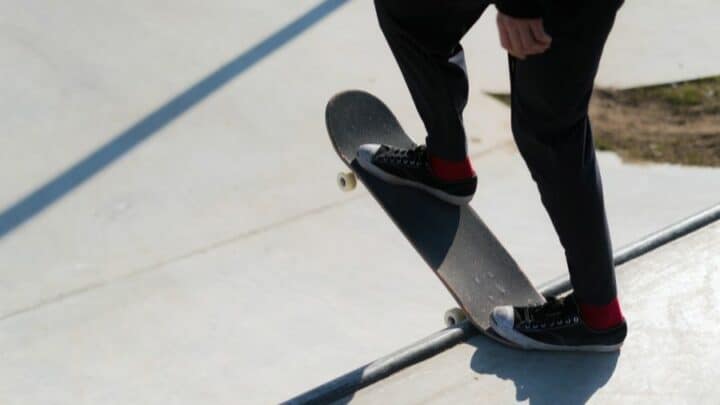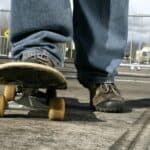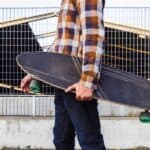Once you’ve learned to balance on your board and you’re a fairly confident rider, you may be starting to explore the possibility of visiting your local skate park.
Granted, ramps can be intimidating at first, but if you know how to drop in, you’ll be much better prepared for what’s to come.
It takes almost as much skill as it does mastery of apprehension, but with a little confidence and research, you’ll be just fine. Read on to find out how to drop in on a skateboard ramp.
Table of Contents
How to Drop In on a Skateboard
Position yourself on the ramp’s edge, with your back foot on the board’s end. Your rear wheels must be over the ramp’s coping (rim), and the board’s nose should be in the air. When you’re ready to drop in, place your front foot on your front truck bolts and lean into the fall before quickly redistributing your weight to both legs.
Safety First
Hobby skaters and professionals alike will tell you that skateboarding is as much a mental game as a skill game. Much of skating is about your confidence and how willing you are in taking chances.
When you’re just starting out, you can expect a couple of bumps, scrapes, and bruises, but you may want to be extra careful when it comes to visiting the skatepark.
Ramps and bowls are higher stakes, and you can hurt yourself seriously if you don’t take precautions.
Thus, it’s advisable to invest in some safety gear if you are not yet a confident rider.
While it’s not a prerequisite, a helmet and a few knee and elbow pads will go a long way to preventing unnecessary hurt.
In no time, you’ll have the guts and muscle memory to conquer the skatepark safety-gear-free.
Getting into Position
When dropping in, your starting position is extremely important.
You want to prevent your skateboard from hooking on the edge of the ramp, yourself from falling over backward, or from slamming your nose down into the ramp. All of these will find you on the ground.
To get into the correct position to drop in, first place your skateboard with the wheels over the rim of the ramp. This rim is called a coping and looks like a raised lip.
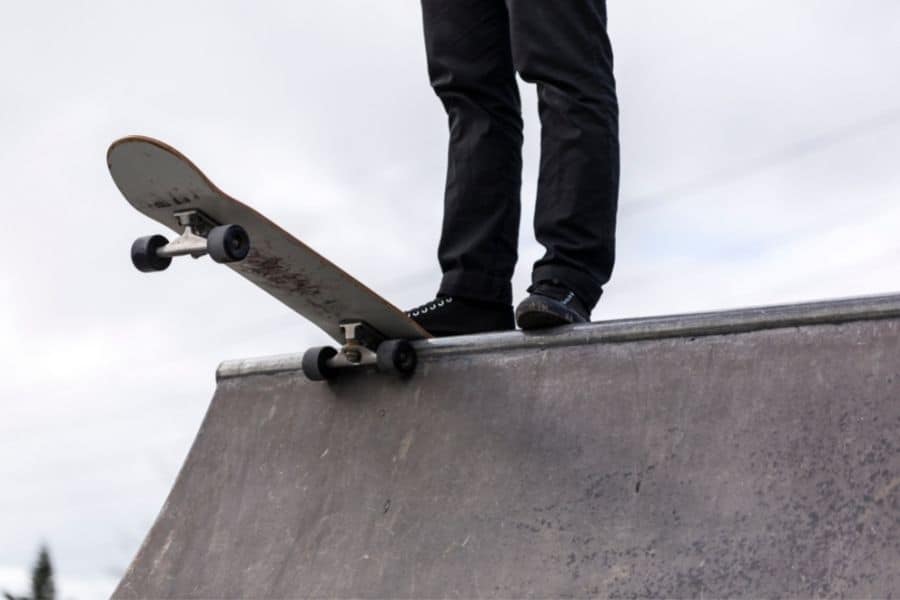
Your back foot should be on the tail end of the skateboard (on level ground), quite far backward, but not over the end of the board.
The front of your board should be pointing upward towards the sky.
Next, you’re going to position your front foot over the truck bolts at the front end of your skateboard.
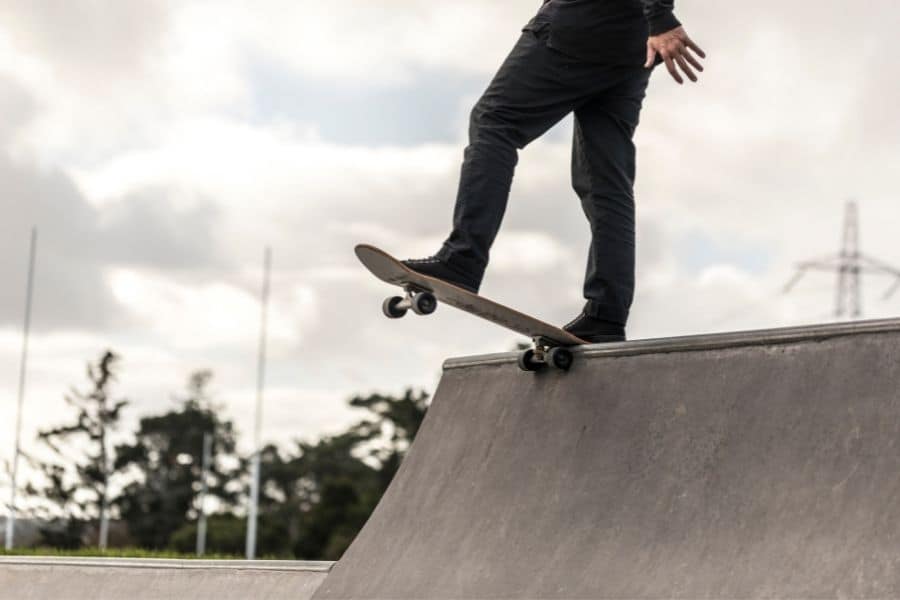
Once you’re in this position, you’re just about ready to drop in.
Dropping in on a Skateboard Ramp
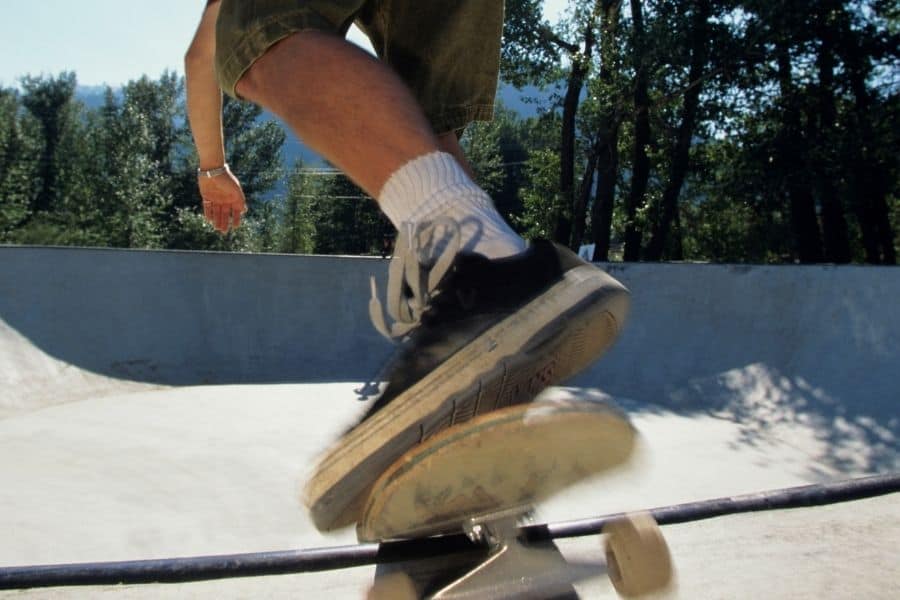
Dropping in on a ramp isn’t complicated, but it can be nerve-wracking. It’s a tentative balance game that is easy to get wrong.
Once you’re positioned on your board, the last thing you want to do is stiffen up. The movement of your body determines whether you’ll have a successful drop-in or not.
To ready yourself, start by bending your knees, as is usual when you’re riding.
Lean a little bit forward to gain the momentum to touch your front wheels to the ramp and then quickly balance yourself by redistributing your weight to both legs.
While this is easier said than done, be confident in your body and let it guide you to a natural state of balance once you’ve entered the ramp.
Eventually, with some practice, dropping in on a ramp will become natural.
As a beginner, try your best not to slam your nose into the ramp by leaning too far forward or shooting it out from under your feet by tilting too far back.
Getting Comfortable in the Skatepark
Before you start dropping in on ramps, it’s a good idea to get comfortable at the skatepark with some transition riding.
Transition skateboarding is where you go from being horizontal to skateboarding on bowls, ramps, or other inclines.
Skate around the bottom of the ramp or bowl to get a feel for the material it’s made of too. It may be comprised of concrete, wood, or metal, all of which can feel very different and have different speeds.
Don’t try tricks until you’re okay with the basics.
Frequently Asked Questions about How to Drop In on a Skateboard
Are bigger wheels better for transition skating?
Different size wheels work for different aspects of skating. For ramps and bowls, it’s nice to have bigger wheels as they are more stable at high speeds. However, smaller wheels are better for tight turns and tricks.
How do I drop in safely?
What’s tricky about dropping in is that there is no horizontal ground to jump off onto. For this reason, it isn’t easy to guarantee safety when dropping in. The best way to do it is to commit, keep your feet on the board, and wear safety gear.
What is the best skateboarding trick to learn first?
Most skaters recommend that the best trick to learn first on a skateboard is the ollie. This simple jump is easy to master and not too dangerous to attempt. Wear safety gear if possible to prevent too many unnecessary injuries.
The Last Drop In
There’s an unrivaled pleasure that comes with mastering the art of dropping in. It takes regular skateboarding to an entirely different level.
And while it may seem complicated, so much of it comes down to confidence, and of course, practice and perseverance.
